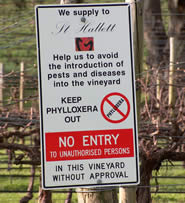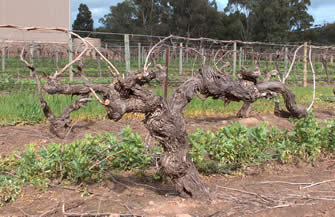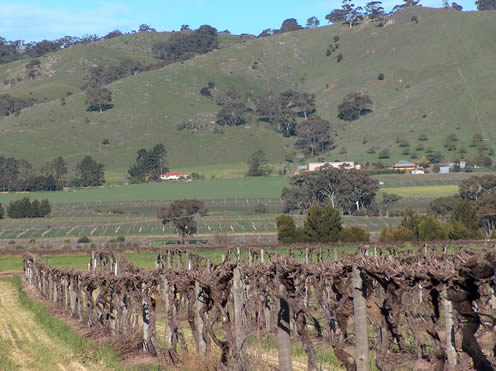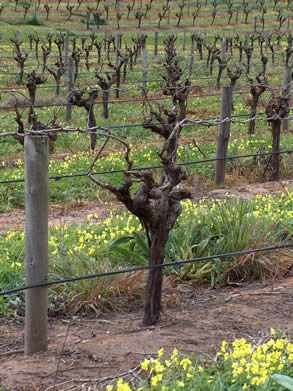|
The
New Barossa
Part 1:
introduction

The Barossa currently has a
bit of a buzz about it, and I’d travelled there to meet the next
generation of potential winemaking stars. Of course, every wine
writer tends to think the most dynamic, buzzing and exciting wine
region is the one they’ve just visited, but the Barossa genuinely
seems to be a region on the up.
Historically, the Barossa
has been the spiritual home of the Australian wine industry. The
first vines here were planted in the mid-19th century by German
immigrants keen to recreate the wines of their homeland – hence
Riesling was a popular choice. Grenache, Mourvèdre and Shiraz also
found their place. For much of the Barossa’s history the focus has been predominantly
on fortified wine styles, which were very popular, and to some extent easier to make
in this warm climate than table wines. At Langmeil winery an old
poster – from when the winery used to be called Paradale, in the
1950s – illustrates how fashions have changed. It advertises 12
wines: five Ports, three Sherries, two Muscats and just two
‘beverage wines’ – Hock and Claret.
This region has seen some
difficult times. Most recently, the Barossa suffered in the
vine-pull scheme of the 1980s when many of the fantastic old Shiraz
and Grenache vineyards were uprooted as the focus of the Aussie wine
industry shifted to cooler-climate sites and to Cabernet Sauvignon,
away from warmer areas and the more traditional varieties.
 Things
revived in the late 1980s and early 1990s when the likes of Charles
Melton, Peter Lehmann, Rockford and St Halletts raised the profile
of the Barossa as a source of characterful, uniquely Australian
wines, and the momentum here has been growing ever since. Change and
renewal are a natural part of life, though, and as with many wine
regions across the globe, a new generation is now emerging, keen to
make the most of the Barossa’s precious resource of old vines. Things
revived in the late 1980s and early 1990s when the likes of Charles
Melton, Peter Lehmann, Rockford and St Halletts raised the profile
of the Barossa as a source of characterful, uniquely Australian
wines, and the momentum here has been growing ever since. Change and
renewal are a natural part of life, though, and as with many wine
regions across the globe, a new generation is now emerging, keen to
make the most of the Barossa’s precious resource of old vines.
The Barossa has some of the
world’s oldest commercial vineyards. South Australia has been
spared from phylloxera, which is now kept out by an effective and
strictly enforced quarantine. Vines are almost always planted here
on their own roots, and there are quite a few vineyards with vines
100 years old and counting. The oldest vineyard with its original
vines that I’ve seen dates from 1843, and it’s amazing to think
that these  ancient
vines, dramatically knarled and twisted, are good for anything. As
an aside, there’s the intriguing scientific question of why old
vines are preferred to new ones: many scientists suggest that it’s
their naturally low vigour that is responsible for the better grapes
they are reckoned to produce. Whatever the explanation, there are
plenty of fantastic old vine vineyards here, and the good news is
that the ambitious young winemakers can get their hands on them.
Here’s why. ancient
vines, dramatically knarled and twisted, are good for anything. As
an aside, there’s the intriguing scientific question of why old
vines are preferred to new ones: many scientists suggest that it’s
their naturally low vigour that is responsible for the better grapes
they are reckoned to produce. Whatever the explanation, there are
plenty of fantastic old vine vineyards here, and the good news is
that the ambitious young winemakers can get their hands on them.
Here’s why.
 One of the key facets
contributing to the current dynamic state of the Barossa is that
most vineyards are owned by growers who have no ambition to make
their own wine from them. These tend to be long-term residents who
see themselves as career grapegrowers. Fortunately, the Barossa has
largely been spared the influx of retired doctors, lawyers and
bankers who have flocked to regions such as the Hunter –
‘lifestylers’ who want to live the wine dream, and whose
‘vanity’ wines are rarely interesting. The fact that most
vineyards here are grower-owned has lowered the bar of entry of
passionate but capital-poor young winemakers. They can spot a
promising vineyard, pay double what the big company was previously
buying the grapes for (usually remarkably little), and make wine
they way they want, often in the corner of someone else’s winery. One of the key facets
contributing to the current dynamic state of the Barossa is that
most vineyards are owned by growers who have no ambition to make
their own wine from them. These tend to be long-term residents who
see themselves as career grapegrowers. Fortunately, the Barossa has
largely been spared the influx of retired doctors, lawyers and
bankers who have flocked to regions such as the Hunter –
‘lifestylers’ who want to live the wine dream, and whose
‘vanity’ wines are rarely interesting. The fact that most
vineyards here are grower-owned has lowered the bar of entry of
passionate but capital-poor young winemakers. They can spot a
promising vineyard, pay double what the big company was previously
buying the grapes for (usually remarkably little), and make wine
they way they want, often in the corner of someone else’s winery.
 The grower benefits from
both the higher price they get for the grapes and the fact that they
can often taste a bottle that comes from their vineyard, rather than
seeing the grapes disappear into some huge blend. The most far
sighted of the winery owners don’t mind their young winemakers
doing a bit of homebrew, because they know they’ve got a better
chance of keeping the best ones longer if they allow them a project
which they have the creative
direction and ownership of. It’s a story that’s been repeated
dozens of times in the Barossa over the last few years, to the
extent that it’s hard to keep track of
what’s going on – tough for wine writers and buyers, but
good for the health of the wine scene here. The grower benefits from
both the higher price they get for the grapes and the fact that they
can often taste a bottle that comes from their vineyard, rather than
seeing the grapes disappear into some huge blend. The most far
sighted of the winery owners don’t mind their young winemakers
doing a bit of homebrew, because they know they’ve got a better
chance of keeping the best ones longer if they allow them a project
which they have the creative
direction and ownership of. It’s a story that’s been repeated
dozens of times in the Barossa over the last few years, to the
extent that it’s hard to keep track of
what’s going on – tough for wine writers and buyers, but
good for the health of the wine scene here.
The goal of this series is to introduce some of the new winemakers
and talents emerging from the Barossa, telling the stories of wines
that look set to move this region forward to greater things over the
next decade. I’d been sufficiently impressed by tasting some of
these wines in London that I paid my own way to visit the Barossa
and see what was going on at first hand in September 2004. I then
followed this up with a second visit in October 2005. The roll-call
here is by no means a comprehensive list of the producers doing good
work, but I hope it conveys an impression of what’s going on and
introduces readers to some new names who deserve the recognition, as
well as catching up on a few more established producers. Unless
indicated otherwise, the reports here are from the initial 2004
visit.
Part 14: Teusner
Part
15: Troy Kalleske
Part
16: Clancy Fuller
Part
17: Domenic Torzi, revisited
Part
18: Rusden
Part
19: Kym Teusner, revisited
Part
20: Veritas, revisited
Part
21: Greg Hobbs, revisited
Part
22: Massena vertical
Back
to top
|

